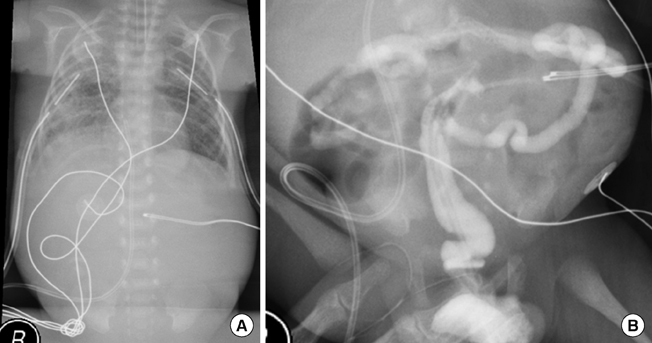J Korean Med Sci.
2012 Oct;27(10):1269-1272. 10.3346/jkms.2012.27.10.1269.
A Case Report on 30-Week Premature Twin Babies with Congenital Myotonic Dystrophy Conceived by In Vitro Fertilization
- Affiliations
-
- 1Department of Pediatrics, Cheil General Hospital and Women's Healthcare Center and College of Medicine, Kwandong University, Seoul, Korea. envy300@naver.com
- KMID: 1778838
- DOI: http://doi.org/10.3346/jkms.2012.27.10.1269
Abstract
- Congenital myotonic dystrophy type 1 (DM1) presents severe generalized weakness, hypotonia, and respiratory compromise after delivery with high mortality and poor prognosis. We presented a congenital DM1 of premature twins in the 30th week of gestation. These twins were conceived by in vitro fertilization (IVF). Both babies presented apnea and hypotonia and had characteristic facial appearance. They were diagnosed DM1 by genetic method. They were complicated by chylothorax and expired at 100 and 215 days of age, respectively. Mother was diagnosed DM1 during the evaluation of babies. This is the first report on congenital DM1 which accompanied the chylothorax. More investigation on the association with chylothorax and congenital DM1 is recommended. With a case of severe neonatal hypotonia, congenital DM1 should be differentiated in any gestational age. Finally, since DM1 is a cause of infertility, we should consider DM1 in infertility clinic with detailed history and physical examination.
MeSH Terms
Figure
Reference
-
1. NIH. Gene reviews. accessed on 22 May 2012. Available at http://www.ncbi.nlm.nih.gov/books/NBK1165/.2. Nam SH, Son YB, Lee BL, Lee JH, Ki CS, Lee MH. Clinical characteristics of congenital myotonic dystrophy diagnosed by molecular genetic method. Korean J Pediatr. 2007. 50:868–874.3. Kim SH, Kim EY, Park SK, Choi SJ, Lim SC. A case of congenital myotonic dystrophy diagnosed by molecular genetics. J Korean Soc Neonatol. 2006. 13:194–198.4. Oh JH, Lee JY, Lee JS, Choi JC, Kang JH, Kang SY. Congenital myotonic dystrophy diagnosed in an adolescent period. J Korean Neurol Assoc. 2008. 26:383–386.5. Sarnat HB. Kliegman RM, editor. Myotonic muscular dystrophy. Nelson textbook of pediatrics. 2011. 19th ed. Elsevier;2123–2126.6. Brook JD, McCurrach ME, Harley HG, Buckler AJ, Church D, Aburatani H, Hunter K, Stanton VP, Thirion JP, Hudson T, et al. Molecular basis of myotonic dystrophy: expansion of a trinucleotide (CTG) repeat at the 3-prime end of a transcript encoding a protein kinase family member. Cell. 1992. 68:799–808.7. Turner C, Hilton-Jones D. The myotonic dystrophies: diagnosis and management. J Neurol Neurosurg Psychiatry. 2010. 81:358–367.8. De Temmerman N, Sermon K, Seneca S, De Rycke M, Hilven P, Lissens W, Steirteghem AV, Liebaers I. Intergenerational instability of the expanded CTG repeat in the DMPK gene; studies in human gametes and preimplantation embryos. Am J Hum Genet. 2004. 75:325–329.9. Campbell C, Sherlock R, Jacob P, Blayney M. Congenital myotonic dystrophy: assisted ventilation duration and outcome. Pediatrics. 2004. 113:811–816.10. Lee SYR, Chan KY, Chow CB. Survival of a 30-week baby with congenital myotonic dystrophy initially ventilated for 55 days. J Paediatr Child Health. 1999. 35:313–314.11. Curry CJ, Chopora D, Finer NN. Hydrops and pleural effusions in congenital myotonic dystrophy. J Pediatr. 1988. 113:555–557.12. Afifi AM, Bhatia AR, Eyal F. Hydrops fetalis associated with congenital myotonic dystrophy. Am J Obstet Gynecol. 1992. 166:929–930.13. Stratton RF, Patterson RM. DNA confirmation of congenital myotonic dystrophy in non-immune hydrops fetalis. Prenat Diagn. 1993. 13:1027–1030.14. Smets K. X-linked myotublar myopathy and chylothorax. Neuromuscul Disord. 2008. 18:183–184.15. Schröder JM, Durling H, Laing N. Actin myopathy with melamine bodies, intranuclear rods, and a heterozygous mutation in ACTA1 (Asp154Asn). Acta Neuropathol. 2004. 108:250–256.16. Reece EA, Lockwood CJ, Rizzo N, Pilu G, Bovicelli L, Hobbins JC. Intrinsic intrathoracic malformations of the fetus: sonographic detection and clinical presentation. Obstet Gynecol. 1987. 70:627–632.17. De Andoin NG, Echeverria J, Cobo AM, Rey A, Paisan L, De Munain AL. A neonatal form of Steinert's myotonic dystrophy in twins after in vitro fertilization. Fertil Steril. 2005. 84:756.e5–756.e8.18. Foresta C, Ferlin A, Gianaroli L, Dallapiccola B. Guidelines for the appropriate use of genetic tests in infertile couples. Eur J Hum Genet. 2002. 10:303–312.19. Rudnik-Schöneborn S, Klaus Z. Outcome in pregnancies complicated by myotonic dystrophy: a study of 31 patients and review of the literature. Eur J Obstet Gynecol Reprod Biol. 2004. 114:44–53.20. De Rademaeker M, Willem V, Martin DR, Sara S, Karen S, Sonja D, Maryse B, Josianne VE, Paul D, Inge L. Preimplantation genetic diagnosis for myotonic dystrophy type 1: upon request to child. Eur J Hum Genet. 2009. 17:1403–1410.
- Full Text Links
- Actions
-
Cited
- CITED
-
- Close
- Share
- Similar articles
-
- Twin pregnancies conceived by In-vitro fertilization compared with normally conceived twin pregnancies: Maternal and neonatal outcome
- Clinical Consideration of Premature Twins Conceived by in Vitro Fertilization and those of Naturally Conceived
- Pregnancy Outcome of In Vitro Fertilization Twin Pregnancies compared withNormally Conceived Twin Pregnancies
- A Case of Congenital Myotonic Dystrophy
- A Case of Heterotopic Pregnancy Following in vitro-fertilization


